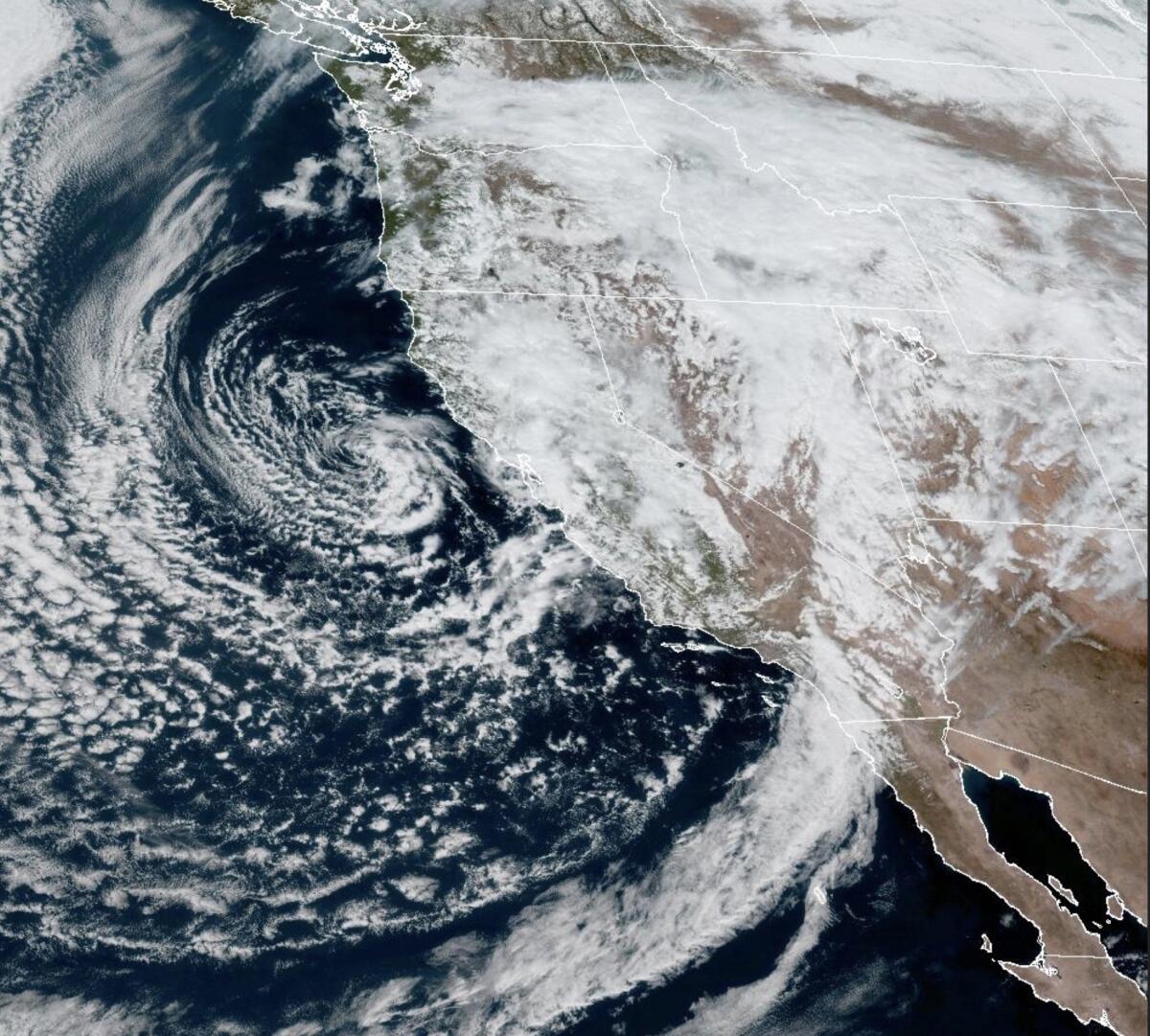Bomb cyclone, atmospheric river, polar vortex: How our weather terminology has grown with recent wild storms

- Share via
Californians have been warned over the past few months about weather ranging from a “vicious heat dome” to back-to-back “atmospheric rivers,” and the always-concerning “bomb cyclone.”
While it might feel as though recent weather has been dominated by a string of new phenomena, experts say these terms and events are well-established in the scientific world but simply novel to much of general public.
Many of these meteorological terms have entered the public discourse in recent years due to a combination of factors: more extreme weather in the age of climate change, a new wave of scientific journalism and the virality of the internet and social media, which often helps promote such eye-catching phrases.
”We are hearing these terms more, and I think partially that’s in reaction to [the fact that] the weather’s gotten crazier,” said Jeff Masters, a meteorologist and writer for Yale Climate Connections. The terms “have been around scientifically for a long time, but they’re getting dusted off and trotted out here to … capture the extremity of what we’re seeing.”
California is in store for extreme weather this week, with excessive heat advisories expected to last into the weekend while deadly riptides, flash floods and thunderstorms could bring their own hazards to the state.
James Marshall Shepherd, director of the University of Georgia’s Atmospheric Sciences Program, also credits a new wave of meteorological journalism for helping popularize these more scientific — as well as attention-grabbing — terms. That includes meteorologists writing for climate-focused websites or within established news outlets, like the Washington Post’s Capital Weather Gang.
“They started to bring some of that terminology out of the science literature into more popular writing,” Marshall Shepherd said. “These things like polar vortex and bombogenesis and atmospheric river and derecho, every one of those have been around for decades, particularly in the atmospheric sciences [and] meteorology literature.”
Most call the development overwhelmingly positive, but there’s a growing concern that these dramatic-sounding terms can get “misused and abused in different circles,” said Daniel Swain, a UCLA climate scientist.
“I think that sometimes using the more colorful language is helpful in a science communication perspective,” Swain said. “But you do need to present things in context.”
“Polar vortex” is one term that multiple meteorologists cite as often misused, pointing out how it has sometimes been inaccurately cited as a developing weather pattern when it properly refers to a regularly occurring air mass over the Arctic.
To better understand some of these new-sounding weather phenomena, Times staff dived into the archives to see how long these phrases have made the news, and asked experts about their scientific origins and true meaning.
A look at each term:
- Atmospheric river: a concentrated stream of water vapor in the middle and lower levels of the atmosphere that travels across the ocean until some land mass obstacle forces it to expel its moisture.
In the scheme of meteorological terms, “atmospheric river” is relatively new, cited in scientific papers only in the last 30 years, Masters said.
He said the phenomenon had been identified as early as 1939, but it wasn’t until 1992 that a paper coined the term “tropospheric river.” That later morphed into atmospheric river simply to make the terminology “more accessible,” Masters said.
“Now that we have high-resolution satellites and we’ve been flying research aircraft into these atmospheric rivers, we’re really learning a lot more about them that we didn’t know,” Masters said.
Officials at Big Bear Mountain Resort, half-buried under the heaviest snowfall there in more than 20 years, said they would be extending their season through April 30.
Some of these events are often also referred to as pineapple expresses, which experts say is a more colloquial term for some atmospheric rivers that originate near the Hawaiian islands.
The term “atmospheric river” first appeared in The Times in 1993, in a story that focused on the research paper that first named the phenomenon. The phrase didn’t appear back in print for almost two decades, when meteorologists and scientists in 2011 warned that California could be vulnerable to them.
Much has changed in a decade. So far in 2023, the term has appeared in dozens of Times articles.
- Bomb cyclone; bombogenesis: the rapid intensification of a cyclone or low-pressure system; the formation of such a rapidly strengthening system.
The phenomenon was first coined as a “bomb” in a 1980 paper that focused on cyclones rapidly, or explosively, developing, according to the Washington Post. The authors used the word to help convey the strength and danger of such storms, but the phenomenon had long been studied by meteorologists.
“Somehow, it just found its way into the common lingo in recent years, because it is dramatic and it’s descriptive,” Masters said.
As Tuesday’s storm approached the Bay Area, the system developed two “eyes,” or areas of low pressure, that danced around each other and intensified dangerous winds.
For the public, the term is still relatively new, not having made it into The Times until 2018, when reporters used both “bomb cyclone” and “bombogenesis” to describe a major storm hitting the northeast U.S.
The phenomenon was credited for the strong and deadly storm that hit California last week, and Swain said the U.S. will likely see another such storm soon.
“There are about 40 or 50 quote-unquote bomb cyclones per year in the Northern Hemisphere,” Swain said, but he added that they are more likely to develop over the North Atlantic and in the Gulf of Alaska than off the Northern California coast.
One person was killed in the storm that brought widespread rain, gusts that knocked glass out of skyscrapers and left tens of thousands without power.
- Polar vortex: upper-level air masses that regularly circulate over the Earth’s poles and are typically confined to those regions by the polar jet stream — though it can get disrupted, letting some of that cold air escape toward the equator.
This term jumped into the public’s consciousness during some particularly cold storms on the East Coast. It was used in a science writer’s 2014 post and picked up by other media. But Masters said the term has been around since the 1930s.
Masters said this term has drawn some of the most concern from him and his peers because it’s more of a stratospheric phenomenon — in the atmosphere’s higher, second layer — so it’s not as relevant meteorologically, though it can have some effect on Earth’s weather.
“The weather in the stratosphere doesn’t really impact what’s going on down on the ground,” Masters said, explaining why he usually avoids using the term, which he thinks has been “misused and overhyped.”
The Times first used it in a scientific sense in 1992, describing a trip to the Arctic to study the atmosphere there. It wasn’t until 2014 that it was used in a weather story.
- Heat dome: a more colloquial term that describes a hot, high-pressure system that isn’t moving anywhere anytime soon.
Experts said this term is not as entrenched in the scientific literature but is still an accurate description for a massive heat wave; some meteorologists have said it could also be considered a heat bubble.
“It’s just a big old high-pressure system that’s hot,” Masters said. “You can think of it as a dome, why not?”
This term was first used in the context of weather in The Times in 2012, describing a long, hot event in Greenland, melting a massive ice sheet. It has been used multiple times in recent years.
- Supercell thunderstorm: a thunderstorm with a rotating updraft, or upward motion, that can cause more extreme weather.
These thunderstorms are some of the most intense and organized storms, which can last several hours and spin off tornadoes or cause hail, experts said.
“You can go back into textbooks 50 years ago and see people talking about supercells,” Marshall Shepherd said, calling them “basic meteorology.”
But the term hasn’t been so common in weather reporting, not appearing in The Times until 1999, when it was mentioned in a story about a chain of tornadoes that swept through Oklahoma and Kansas.
- Thundersnow: the rare combination of thunder and lightning during a snowstorm.
While far from a new term, Marshall Shepherd thinks the word likely grew in prominence after a Weather Channel meteorologist geeked out as he experienced the phenomenon in Boston 2015.
“Thundersnow is very rare,” Marhsall Shepherd said. “It’s not that common that you get thunderstorms in a snow environment.”
It first made it in The Times in 2007, after thundersnow was recorded in Southern California, and has since had increasing mentions, including this winter.
More to Read
Sign up for Essential California
The most important California stories and recommendations in your inbox every morning.
You may occasionally receive promotional content from the Los Angeles Times.

















